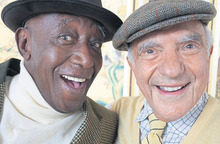Boosting the elderly
Louise Morse tells us about some remarkable help for people with dementia
Louise Morse

I’m not sure if other languages have a phrase for saying ‘the proof of the pudding is in the eating’.
But when we put together different ingredients for brain-boosting sessions for older people in one of the housing complexes of Pilgrims’ Friends Society, that’s exactly what we were looking for – proof that people working together in a group, receiving mental and spiritual stimulation, would bring positive results.
We came up with a concept, chose the ingredients, mixed them all together and tried them out – the results were better than we had imagined. The thing we hadn’t expected, but which proved to be the most beneficial of all for those involved, was the sense of close community and of belonging that developed among participants.
Adaptable brain
More and more studies were confirming the plasticity of the brain and how it responds to stimuli, so we (Janet and I) wondered what the results would be if we mixed together some cognitive stimulation with spiritual support, self-affirmation and sense of achievement with fellowship and fun, and put them into a format with changing content that could be repeated as part of a series. An important premise was that participants would be working together.
In our plan we wrote – Aims: a) cognitive stimulation, reinforce and affirm individual identity, especially in Christ, b) increase sociability, c) provide sense of achievement, d) boost spiritual awareness (thankfulness, worship, connectedness) and e) enjoy companionship and engagement and have fun.
We called the series ‘Brain and Soul Boosting for Seniors’, and tried it initially with people living independently in the housing complex. The self-affirmation element was particularly important because as they become frailer older people sometimes feel ‘less than’ and their sense of worth diminishes. As people with dementia become more and more affected by failing memory they, too, benefit by having their sense of identity and value confirmed.
Desired outcomes
Janet’s entire career has been caring for older people, first as a psychogeriatric nurse and then in managing care homes. She has a natural affinity for older people and a reassuring, soothing manner and if ever I become old and frail I’ll ask the Lord to send me an identikit Janet. So, after the sessions had been themed and we’d decided what outcomes we’d like to see, we put the idea to the managers in the housing complex. We thought it would appeal to occupants who would like to keep their brains sharp, but the care manager, Georgina, enthused a group of people who had early dementia and that’s how it started.
Sometimes there were six people, sometimes eight and occasionally ten, but because the approach is very ‘person centred’ Janet found the ideal number was eight. They came with different backgrounds, abilities and interests; they included a minister and pastor, a music teacher, an architect and an art teacher. Some had difficulty in speaking, a couple had severe memory impairment, one person had mild cognitive impairment and so on, but they brought themselves and a willingness to engage with Janet and with each other.
One lady in particular was always anxious when she came in, wringing her hands and sometimes very hesitant about even coming in, but by the end of each session she was always smiling and happy and less anxious.
Remarkable results
The ‘proof of the pudding’ was better than we’d thought. After a couple of months participants had become a friendship group, sitting with each other at mealtimes in the dining room and helping each other in different ways. Janet remembers that the two with the severest impairments, who had difficulty speaking, became especially firm friends. They were all far less anxious and had improved memories, finding it easier to find their way back to their apartments and some, said Georgina, would not need reminding of the day that the meeting was held – they remembered.
She noticed, too, that the change in the ‘dementia group’ had affected everyone else living there. She said: ‘The dread of dementia is dead here. The atmosphere is totally transformed. Others feel more confident to help people (in the group), for instance, they’ll turn them round if they see they’re going the wrong way and they’re sitting behind them at devotions and handing them the hymn book at the right place.’
Outstanding moments
Janet recalls some outstanding moments. Walter, who had difficulty with words, volunteered to close with prayer and it was such a lovely prayer that everyone looked to him to close each session.
And Janet especially remembers the session on ‘Avocado – hailed as the new anti-aging super food’. She recalls: ‘We discussed the item and decided we need a variety of foods to be healthy, which is more important than fad diets and ‘in’ foods. During the warm-up quiz one of the ladies, who has difficulty with reasoning and with recalling memories, surprised us by voluntarily offering an answer. I had asked for the names of food categories and we wrote them on the flip chart. She said ‘apples and bananas’ and after obviously trying to contribute more said ‘are they fruits’? This is the first time she has contributed since we started the sessions. When I have asked for her input and tried to draw her in to contributing she has always said ‘I am sorry, I can’t remember’. It was a wonderful moment.
‘The activity where pictures of food and their country of origin had to be matched went down very well. Two were easy, two they had to think about and needed a couple of clues, two were more difficult and they mismatched them. I was pleased it seemed to be at the right level for this group.
‘One gentleman appeared to be asleep during the session, only rousing momentarily when prompted. (I felt he looked rather unwell.) However at the end of the session I asked if anyone would like to pray and he immediately started to pray. After having a cup of tea together I was escorting him to the door when he looked at me and said he had Vitamin B12 every three months! As we were looking at the pictures of foods mentioned in the Bible I had talked briefly about lamb being good for providing Vitamin B3 and B12. It was obvious that some of the session had registered with him even though he had not participated!
This blessed me so much. It was a great session and they said they had enjoyed it and would come again. This is a breakthrough as two of the ladies have been reluctant in attending, but both said how good it had been and would be coming next week.’
Didn’t want to miss
On one occasion, Sheila was called out by her GP practice nurse who wanted to take a blood test. It was in the middle of an interesting discussion and Sheila didn’t want to miss a thing, so she insisted the nurse take a blood sample in the corridor outside so she could continue to watch what was happening through the glass door. Apathy and lethargy are twin hazards of old age, so to raise this level of interest is unusual. Janet was particularly blessed when, several months later, as she passed by the big lounge, she spotted Walter, whose dementia had worsened, and smiled at him. His eyes lit up as he so obviously remembered her. Another resident noticed how glad he was to see her.
DVD for churches
We are planning to put the ‘Brain and Soul Boosting’ sessions on a DVD and make them available for churches, for their older folk and for those in their local community. Our experience shows that they work at two levels – for older people who may have mild cognitive impairment and for those with early-mid-stage dementia, bearing in mind that each person is different at each stage.
This is an extract from Dementia: Pathways to Hope by Louise Morse, published by Monarch on 20 November, ISBN 978 0 857 216 557 and is used with permission.


